SEO has become a must for any ecommerce business aspiring to success on the internet. In the face of ever stiffer competition, implementing a high-performance SEO strategy is the key to standing out from the crowd and ensuring long-term success.
As an ecommerce solution, we have in-depth knowledge of sales involving web commerce. Our positioning as the best SaaS online sales solution for SEO demonstrates our expertise in this field.
In this guide, I share with you all the SEO best practices to apply to your ecommerce store.
What is search engine optimization (SEO) in ecommerce?
Search engine optimization (SEO) refers to all the techniques used to optimize a website for search engines such as Google.
In ecommerce, these techniques are similar to those used for other types of sites, such as blogs or storefronts, but they include specific features that are unique to online stores.
To make this explanation more visual, here's an example of a results page, also known as a SERP (search engine result page), for the keyword "litter for cats."
Let's take a concrete example to illustrate SEO in search results.
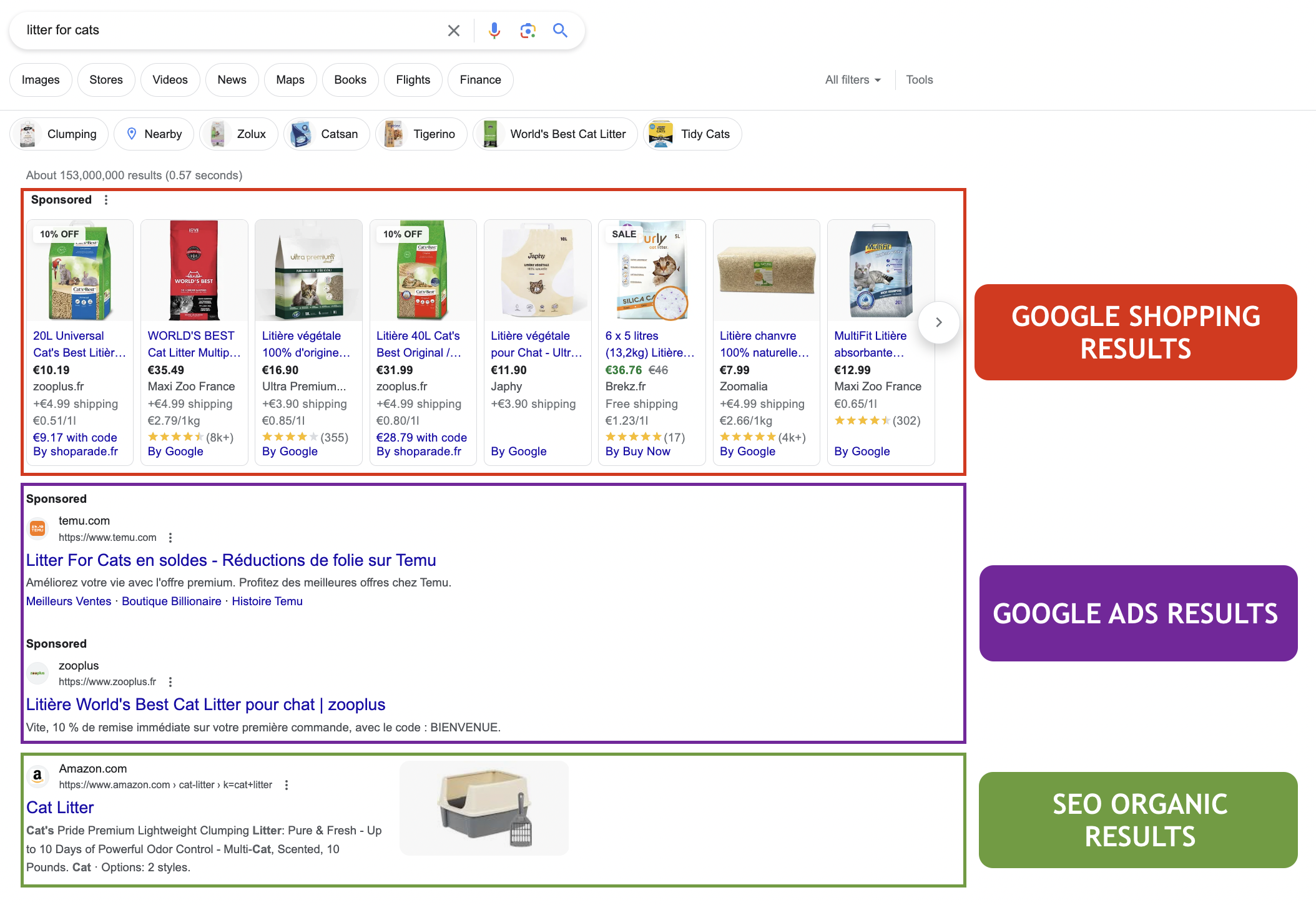
Example of a SERP (search engine results page) for the query "litter for cats"
The SEO results are highlighted in green.
The SEO work carried out on the Amazon site enabled it to rank in the Top 3 for the keyword "litter for cats." For an ecommerce website offering this type of product, appearing at the top of the SERP can significantly boost sales.
This is the kind of goal you need to have with your online store. By following the recommendations in this guide and implementing a rigorous SEO strategy, you can help maximize your visibility, improve your rankings, and attract more potential customers to your ecommerce store.
Why is SEO important for ecommerce? How does it help?
If you're reading this article, the importance of SEO for your ecommerce website has probably already piqued your interest.
To reinforce your conviction and encourage you to pursue this winning marketing tactic, here are a few key statistics:
Inspiring, isn't it? Here are other equally interesting benefits to motivate you to launch a solid SEO strategy:
- Increased visibility: Every day, billions of queries are typed on search engines. The traffic potential is just enormous!
- Qualified traffic: As the above statistics demonstrate, SEO is the marketing lever with the best conversion rates. When internet users express a need, they formulate a query on a search engine and decide to click on your ecommerce website from the results displayed. They find your website on their own, which is what differentiates SEO from other forms of marketing.
- Trust and expertise: Ranking at the top of results on a search engine like Google conveys an image of trust and expertise to users.
- Cost savings: SEO investments are justified by attractive ROI and optimized costs, as evidenced by the statistics and the growing commitment of marketers to this marketing strategy.
- Sustainability: SEO takes time to generate initial results, but once you start to rank and then update your ecommerce site regularly, you'll find that you'll continue to attract qualified traffic on a consistent basis.
- Conversion: Getting your website to rank for keywords that are relevant to your business attracts qualified customers to your site. If your content correctly meets the needs and expectations of Google users, you'll generate conversions and increase your sales.
Getting off to a good start: Technical SEO configurations for an online store
Now that I've motivated you to embark on an SEO marketing strategy for your ecommerce site, I'd like to help you lay the foundations for a high-performance structure.
The technical foundation of your website is fundamental. It plays a decisive role in your online store's SEO.
You can have the best content in the world, but if your ecommerce website isn't properly set up and can't be efficiently crawled by search engines, you'll find that you won't rank and attract more traffic.
Depending on your CMS and the template you're going to install, there are many elements to analyze, configure, and often correct...
If you're using the WiziShop ecommerce solution, you're in luck! All our website designs for internet commerce are perfectly optimized for SEO. You can then choose the one that suits you best, both aesthetically and thematically.
Don't hesitate to check out my complete article to learn more about our native technical SEO optimizations.
Concerning the various technical configurations for high-performance SEO, there are several key points to consider. I'll now list the most important.
If your store is on WiziShop, you can read about the following various technical points, but know that you don't have anything to do on your end, as we manage all these aspects for you, saving you loads of time. You can therefore go directly to the section on launching your SEO strategy.
Sitemap file
The sitemap file is an essential SEO tool.
It lists all the URLs on your site, making it easier for search engine bots to crawl and discover your various pages.
You can usually access your sitemap by adding "/sitemap.xml" to the end of your site's root URL.
A well-configured sitemap file contains only the URLs that are relevant to search engine optimization, i.e., those you want to appear in search engine results.
Robots.txt file
The robots.txt file is another fundamental element of technical SEO.
Incorrect configuration of this file can block crawling by search engine bots, preventing certain parts of your ecommerce website from being indexed.
It's a text file intended for search engine crawlers. You can access it by adding "/robots.txt" to the end of your site's root URL.
Typically, the robots.txt file contains URLs that shouldn't be crawled by robots on your online store. In ecommerce, this includes faceted filters, sorting filters, the shopping cart, customer accounts, etc. These pages, often of no interest to SEO, can waste search engine bots' time when crawling.
Performance
On a technical level, site performance plays a role in search engine crawling and indexing, but it is also essential in ecommerce, as it directly affects visitor conversion rates.
“The probability of bounce increases 32% as page load time goes from 1 second to 3 seconds.” (Source)
Today, it's also imperative that your ecommerce website is adapted to different devices and screen sizes.
It's important to note that, unless your performance is very poor, there's no need to focus too much on your site's loading speed. These optimizations to significantly improve speed can often require significant financial resources. Before trying to achieve speed perfection, keep in mind that it's best to focus first on other aspects of SEO, such as content and authority.
SEO tags
SEO tags are the markup present on every page of your site. You must respect web standards and be able to customize the title tag, the meta description tag, the H1 tag, and the rest of the heading tags or Hn structure.
These elements allow you to optimize your pages for the keywords you're going to target, structure your content, and promote understanding by search engines like Google.
To quickly cite other important technical configurations to check, there's good URL management to prevent duplicate content, the presence of canonical tags, structured data, breadcrumbs, pagination, etc.
Although there are many other technical optimizations that contribute to good SEO, to detail them all would go beyond the scope of this article.
So let's get to the heart of the matter: launching your SEO strategy, which is probably the most important aspect for you!
Launching your SEO strategy: Market analysis
The very first step, before you even get started, is to be sure to take the time to identify the persona likely to buy your products. Knowing this target customer will enable you to better orient your SEO efforts, as well as the overall communication of your ecommerce site.
1. Identify the persona
The first step is to draw up a portrait of a fictitious persona representative of your ideal customer. This persona image includes detailed social, psychological, and geographical characteristics.
- Who are your customers?
- What are their online behaviors?
- What does their day look like?
- What are their purchasing objectives?
- What problems are they looking to solve?
- Etc.
To help you do this, I encourage you to use online tools like Hubspot's: https://www.hubspot.com/make-my-persona.
You can also turn to AI technology to quickly and easily identify a persona. With ChatGPT, all you have to do is indicate the context of your internet commerce store and ask it to create a buyer persona for you.
Prompt example:
Can you create a detailed buyer persona for a XXX online store targeting customers who are passionate about XXX? On this ecommerce site, I mainly sell XXX. For this buyer persona, you must specify the specific demographics, psychographics, consumption habits, and objectives.
By starting with this step, you will have a much clearer idea of the type of people interested in your products. All these elements will help you get to know your audience better, allowing you to be able to talk to these potential customers more effectively.
2. Analyze the competition
Once you've identified your persona, it's a good idea to analyze your main competitors' websites to understand their SEO approach. This benchmark will help you refine your own tactics.
Personally, when I start a project, I like to begin by searching for the names of my products or services directly on Google.
I then analyze the various high-ranking websites that will soon become my direct competitors:
- tree structure
- categories
- content
- blog
- etc.
To deepen your analysis, tools like Ubersuggest can be very useful. This tool allows you to perform up to three free searches per day by registering. While the free version doesn't reveal all the data, it can still provide you with valuable information.
In just a few clicks, you'll get a list of the keywords for which your ecommerce competitors are ranking, the various sites that talk about them, estimated traffic, and much more.
Of course, I'm staying within the SEO framework, but it's just as advantageous to push your analysis further by identifying the acquisition levers, payment/delivery methods offered, prices charged, the design, etc. This will always benefit your business!
Keyword research
Let's get down to the nitty-gritty and start researching the various keywords for your ecommerce website.
This is one of the most important steps in understanding your audience and laying the foundations for how you approach your online store's SEO marketing.
3. Brainstorm
Brainstorming involves asking yourself or your team various questions related to your products. If you've analyzed your competition, you should already have some ideas.
- What product or products do I sell?
- What is my customer looking for?
- What are their related needs?
- What are their problems?
- What terms do my customers use when they talk about my product?
- What activities are related to my product?
- What are the current trends in my field?
- What keywords do my competitors use?
- Etc.
Write down all your ideas in a Google Sheets spreadsheet, for example, to help start the groundwork for your keyword research.
You can use tools like Google, Google Ads Keyword Planner, or Ubersuggest again to help save time.
Don't hesitate to also consult this complete article on keyword research tools.
To finalize your keyword research list, it's important to keep only the keywords that internet users search. Turn again to tools to perform this check.
4. Keyword classification
As you may have noticed when typing keywords on the internet, the typology of results varies. Depending on your search, Google will display category pages, product pages, blog posts, and videos.
This is a point to bear in mind when classifying keywords within your ecommerce site. Your job is to create pages adapted to search intent.
Depending on the keywords typed in, the user may simply be looking for information on a subject, want to visit a particular site, or want to buy a product.
There are four types of search intent:
- Navigational: The user is looking for a specific website or brand.
- Informational: The user is looking for information.
- Transactional: The user wishes to purchase a product or service.
- Commercial: The user is looking for information, reviews, or comparisons concerning a product or service.
I suggest that you add this indication next to your various keywords in your spreadsheet.
By precisely determining the search intent, you will now be able to organize your keywords and classify them to start drawing the tree structure of your ecommerce site.
To make your task easier, I advise you to use a mind map visualization tool: MindMeister. Here's an example that I made:
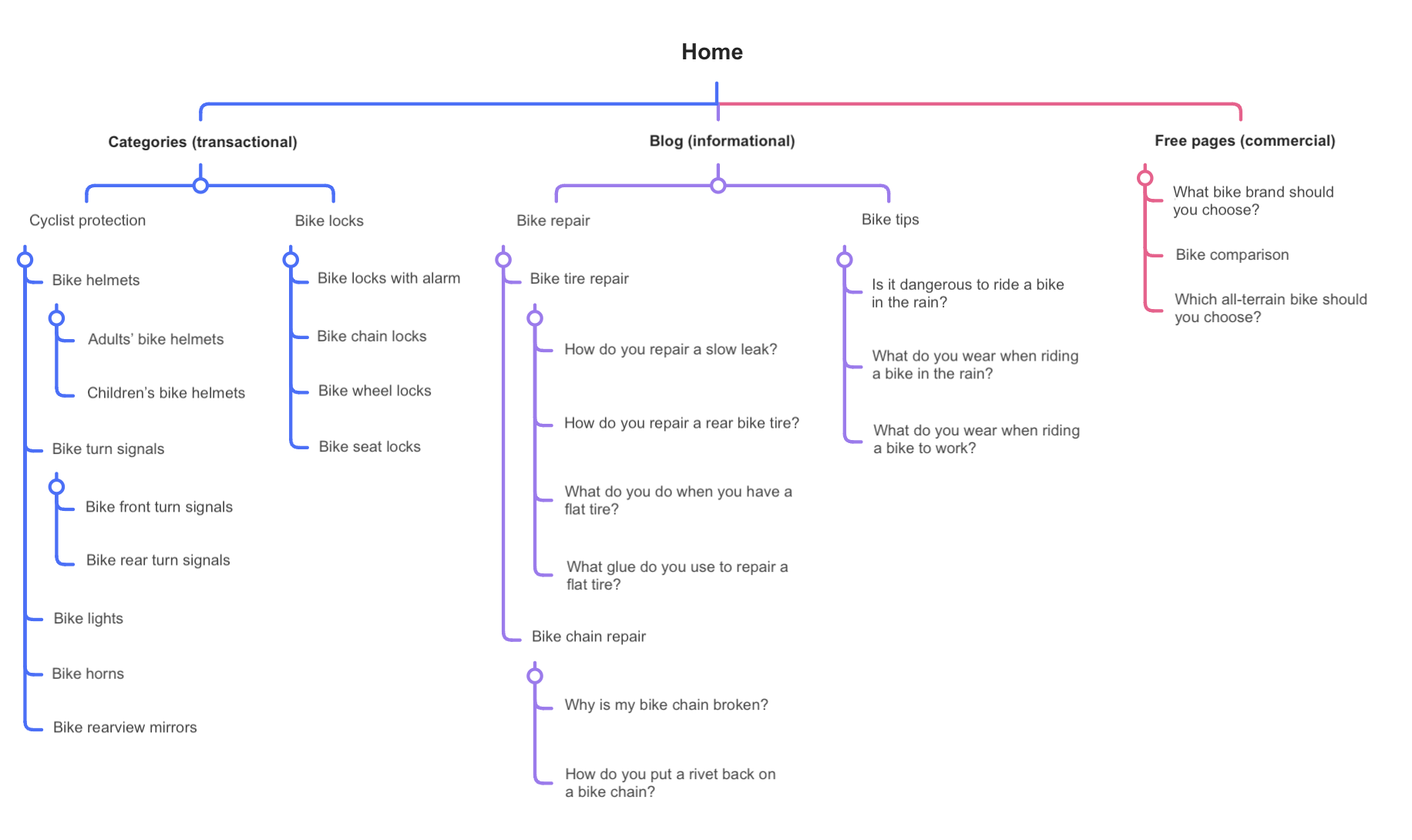
Site structure
The structure of your online store will follow you throughout your ecommerce project. It will play a decisive role in user experience and search engine optimization.
In the previous step, I grouped my different keywords according to search intent and subject granularity (from the broadest to the most precise).
From this work, I can deduce the menu and structure of my ecommerce site:
- Categories
- Subcategories
- Blog
- Buying guide
It's important to keep in mind that one page = one subject (with, of course, its keyword variations).
5. Define the site menu
A site's menu is a crucial element in SEO. It distributes the "link juice" among the different pages of your online store. The pages in your menu will also be the most powerful, as they'll be linked from all over the site.
Most of the time, you'll place your main categories and any subcategories in the menu.
I advise you to avoid mega-menus with more than a hundred links. This will considerably dilute the link juice and thematic coherence between your universes.
Using my example, I can create this menu:
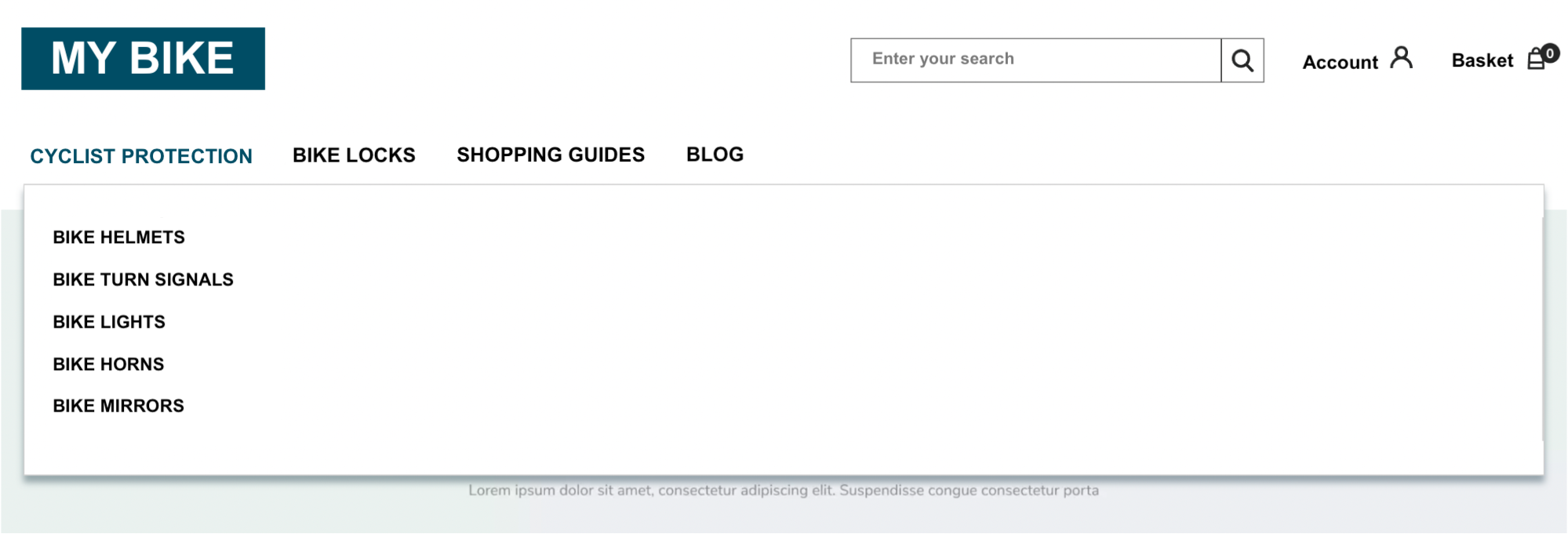
6. Follow precise internal linking
Internal linking is the set of links on your website that enable navigation between pages.
Used by people visiting your site, it's also very useful for SEO. These links within your online store enable search engine bots to find, crawl, and index your site's URLs.
By working effectively with internal links, you can be sure to highlight the most important pages on your site. The more links a page has, the more powerful it will be.
There are several schools of thought when it comes to internal linking: silo, semantic cluster, topic cluster, etc. To begin with, I encourage you to follow the silo internal linking approach, which is particularly popular in ecommerce.
The silo concept consists of grouping content around the same theme within your site and maximizing links within these groups.
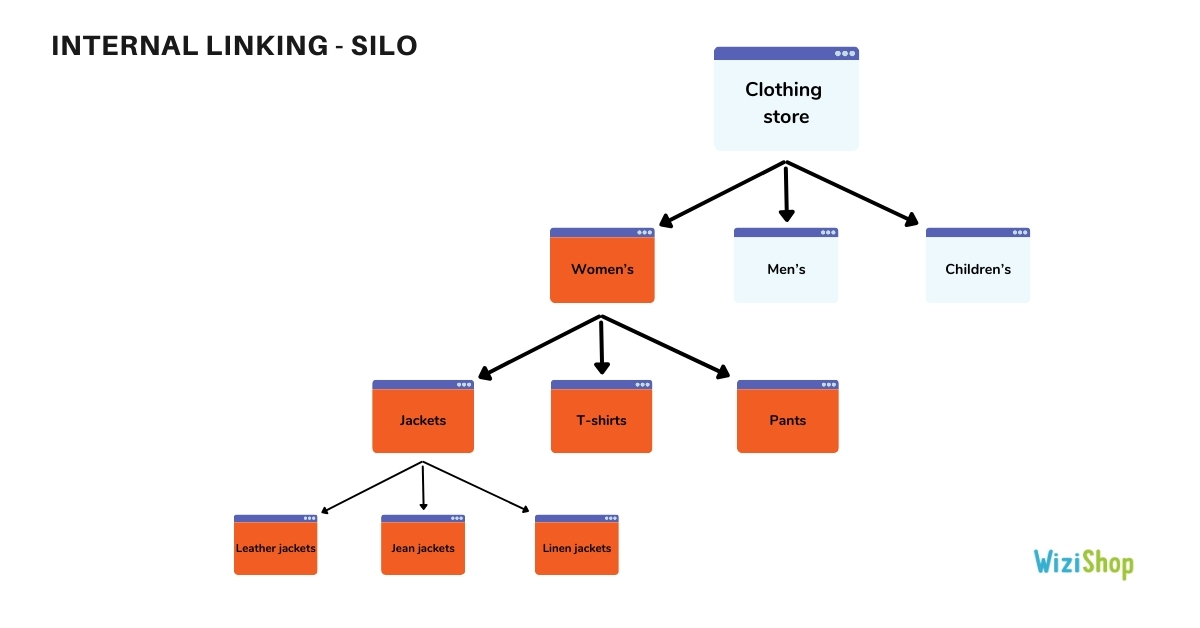
The aim of the silo is to structure information in a logical way, with coherent internal links. If the link between different silos is relevant, don't hesitate to add it—the user experience and conversion on your site must come first.
I encourage you to consult this comprehensive article on internal linking for more details.
Finally, when it comes to the depth of the pages on your site, keep in mind the number of clicks required to access them from the home page. Apply the three-click rule: make sure that your online store pages can be accessed in three clicks or fewer from the homepage.
SEO optimization of ecommerce pages
Now we come to one of the key stages in SEO: content writing.
This is where you'll need to work particularly hard to improve your ecommerce shop's search engine rankings.
The texts you write for content marketing must be optimized not only for search engines, but also for internet users. This is what will encourage your visitors to add your products to their shopping carts and buy them!
In fact, I've written a comprehensive article on writing SEO content that I invite you to read. I break down different types of content that you'll find on a web page (title tag, meta description tag, URL, Hn structure, etc.) and explain, with examples, how to optimize them. It's a point I cover briefly in this article, so consider setting it aside to help you with your writing and further improve your Google rankings.
7. Homepage
This is the main page of your site. And it's also one of the pages of your site where you'll find that you really need to focus on the user experience. Of course, you'll need to maintain good SEO practices, but focus on sales and conversions!
The SEO objectives of this page will be to rank for your brand name and help send power to your other main pages. You can also use it to rank for other keywords such as "keyword in your theme" + store.
Be sure to focus on a unique design that represents your branding and showcases your flagship products. Add context to your page by writing at least 200 to 300 words of content to present your brand and products.
8. Category pages
Category pages, including subcategories, are more than just lists for browsing your catalog. They are key pages for the SEO of your ecommerce website and your business.
These pages play a key role in competitive keyword ranking. They have the potential to generate significant traffic to your site and are essential for presenting your products to visitors and search engine crawlers.
Here are the main optimizations to implement on your product category pages to improve your rankings:
- Target keyword: Target a relevant keyword with transactional search intent.
- Classification: Respect a hierarchical structure within your tree structure when integrating an ecommerce category into your ecommerce site (for example, Bicycle Protection > Bike Helmet > Adult Bike Helmet).
- Title and H1: Write titles incorporating the target keyword, preferably at the beginning.
- Meta description: Write an interesting and relevant meta description to encourage people to click on your link from search results.
- Short, SEO-friendly URL: Keep your URLs concise and descriptive.
- Unique description: Add a description of at least 150 words to contextualize the product category (adapt according to theme and competition).
- Single, compressed images with an alt attribute: Reduce the size of images and describe each image with an alt attribute.
- Internal linking: Insert internal links to related categories, subcategories, brands, and blog posts that people can click on to find and explore other content on your ecommerce website.
Read my full article on category page SEO.
9. Brand pages
An ecommerce site's brand pages are often overlooked, but I urge you to integrate them into your SEO marketing plan. They hold lots of potential for your SEO and sales.
Each product that your web commerce store features generally refers to its respective brand page via an internal link. These brand pages, as part of your internal linking, therefore become very powerful.
SEO optimization of these brand pages is similar to that of category pages.
Be sure to optimize your tags and write a detailed description to contextualize the page. This can be done, for example, with information about the brand: year of creation, history, values, product range, etc.
Don't forget to answer any questions that visitors may have about the brand, such as where its products are manufactured, where its materials come from, or what guarantees it offers.
If you use the WiziShop ecommerce solution, you'll find that these pages are created automatically as soon as you add a brand to your catalog. You can personalize them and optimize them for SEO by adding descriptive content and customizing your title tag and meta description.
10. Product pages
The product page is the final step before the visitor proceeds to the shopping cart. Your main objective should be to create a product page that inspires confidence and encourages the visitor to proceed with the purchase.
From an SEO point of view, product pages are ideal for targeting long-tail keywords. These queries are generally composed of four to five words and are highly specific, making them particularly effective in attracting qualified traffic to your internet commerce site.
Here are the main optimizations to implement on your product pages:
- Target keyword: Depending on your theme and your products, you may not find a target keyword, but you must be sure to respect SEO best practices.
- Title and H1: Write titles that include the target keyword. For example: [Brand] + [Features] + [Product type].
- Meta description: Write a unique meta description to encourage users to click on your link from the search results.
- Short, SEO-friendly URL: Use short, self-explanatory URLs.
- Unique, high-quality descriptions: Add rich, high-quality product descriptions to offer the people visiting your website added value while improving SEO by preventing duplicate content.
- Unique, compressed images with alt attributes: Minimize the size of your images and describe image details with an alt attribute.
- Internal links to similar products: Insert relevant internal links to your buying guides, blog posts, or similar and complementary products.
- Structured data: Integrate structured data to enhance search engine visibility (price, availability, reviews). Don't forget that this data is automatically generated on the WiziShop solution's sites.
Check out my complete article on SEO for product pages.
This editing task can quickly become time-consuming in ecommerce. That's why WiziShop has developed artificial intelligence dedicated to writing content for online sales. In just a few clicks, you can generate the various texts for your pages (product descriptions, blog posts, category descriptions, etc.) and SEO tags (title and meta description). This tool is a major time-saver when it comes to managing your ecommerce website and your day-to-day SEO work.
There are other types of ecommerce pages that can be beneficial to work on to improve your SEO and attract potential customers. You can create buying guides, product-review pages, blog articles, or even topic clusters.
Off-site SEO
The off-site lever is an important pillar of your SEO strategy. It's part of the triptych of content, technical SEO, and authority. It's essential if you want to rank in competitive sectors.
This lever is represented by backlinks. A backlink is what we call an incoming link. It's a hypertext link embedded in a web page, which refers the internet user from a web page to a page on your site.
For search engines, the more quality backlinks a web page has, the greater its authority.
When quality websites add links to your online store, your authority and trust on search engines like Google will increase.
Before you start trying to acquire backlinks to your ecommerce site, there are a few best practices to follow to optimize your results:
- Vary site types.
- Choose sites with traffic and a minimum level of authority.
- Choose sites with a similar or close theme to your own.
- Choose pages dealing with a subject close to your theme.
- Optimize link placement within content.
- Vary link anchors.
- Vary destination URLs.
I'm now going to show you some effective strategies for acquiring links to your online store.
11. Link baiting
One of the best ways to obtain quality backlinks is link baiting.
This strategy involves creating high-performance, eye-catching content to help get websites talking about you and adding links.
Among the techniques that work best, you'll find the following:
- infographic creation
- comprehensive guides
- comprehensive, detailed studies
- online tools
- photos and videos
- etc.
12. Partners
In ecommerce, it's not uncommon to work with partners or suppliers. These business relationships are a great opportunity for your SEO.
Have you considered contacting them and offering to create a link to your online store on their website? In the same vein, think about local websites that list merchants and economic players in your town. Contacting them to obtain a mention or a link can be very beneficial for your SEO.
13. Influencers
If you're lucky enough to have an online store, you have a formidable lever for acquiring links from sites in your field: product testing.
You may have already used influencers to showcase your products on Instagram, TikTok, and other social media networks, but have you thought about using influencer bloggers to acquire links to your online store? It's a highly effective strategy for obtaining quality links at a lower cost.
14. Directories and forums
As soon as your internet commerce site has been created, one of the most popular, quick and easy link-acquisition strategies is to add your site to directories and forums.
Particularly effective just a few years ago, it's advisable not to overuse it today... But not overusing it doesn't mean doing without it! The strategy has simply evolved.
To select a good directory, you need to check that
- the validation is manual,
- the directory doesn't require a return link,
- the latest sites have been added recently,
- the site presentation pages are of high quality,
- the link is dofollow, and
- the directory ranks for keywords.
To select a good forum, verify that
- the forum is active;
- the forum features dofollow links (discussion, signature, profile); and
- the forum ranks for keywords.
15. Guest blogging
Guest blogging (or guest posting) is another effective strategy for obtaining quality links.
This strategy involves listing various blogs and sites in your field, then contacting them to offer to write a quality article.
Admittedly, this doesn't work every time, but with perseverance, you may come across site owners who accept.
16. Platforms
Finally, to finish on the subject of acquiring backlinks, I'll discuss the strategy of buying links.
A good number of sites and companies on the web, whether they involve internet commerce or other themes, don't talk about it, or they may even advise you not to do so, and yet most of them resort to purchasing links via specialized platforms.
It's therefore beneficial to go through link purchasing to accelerate your SEO growth. On the other hand, it must be done thoughtfully. For example, avoid going to 5euros.com and ordering 10,000 backlinks…
Auditing and monitoring the SEO strategy for your website
Now that you know the best practices for implementing an on-site and off-site SEO strategy on your online store, you'll need to regularly audit your site to monitor your results and check that it's functioning properly.
17. Check site health
There are many tools to audit the SEO of your site: Semrush, Screaming Frog, Ahrefs...
For beginners, I recommend Ubersuggest. It's one of the most accessible and least expensive tools on the market. The free version allows you to carry out three analyses per day by registering for free with a limited number of pages. To receive a full audit, the tool also offers a 7-day free trial upon registration.
This analysis will allow you to check if the different SEO elements present on your site are well configured and if you need to implement corrections.
18. Analyze page indexing on Google
If you've just opened your store, search engine bots will start crawling and analyzing it. This means that they'll start indexing the different pages to rank them on search engines!
This is basic SEO. If a page isn't indexed, it can't be listed. Hence the importance of checking the presence of your different pages on Google.
To check the number of pages present in the search engine index and effectively monitor progress, the best free tool at your disposal is Search Console.
Go to the “Indexing” tab then “Pages.” Google displays here the pages of your site that are detected, crawled, and indexed.
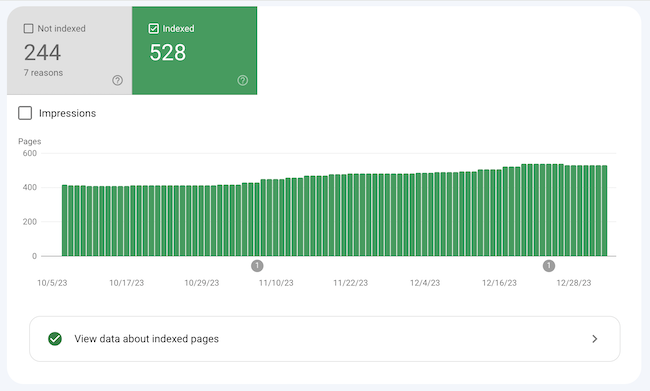
To better understand these reports, be sure to check out the complete article I've written, which presents in detail each element on which you can rely: https://wizishop.com/blog/google-search-console-coverage.
19. Track keyword visibility
Keyword tracking involves monitoring the ranking of different pages of your online store for specific keywords and its progress in search engines. This process allows you to obtain important data and metrics.
Tracking your keywords is available in Search Console, but you can use other tools for more comprehensive, easy-to-view reports.
Ahrefs notably offers a free tool that allows you to have access to a lot of data about your website by simply connecting your Search Console. You can register at https://ahrefs.com/webmaster-tools.
The tool also gives you access to many other free features like backlink auditing and analysis.
Examples of WiziShop sites that do well in SEO
What's better than examples of SEO success to motivate you to get started and draw inspiration from the best players on the market?
Example #1: Boutique de Fruits
This boutique, specializing in the design of fruit bouquets, was launched at the beginning of 2020.
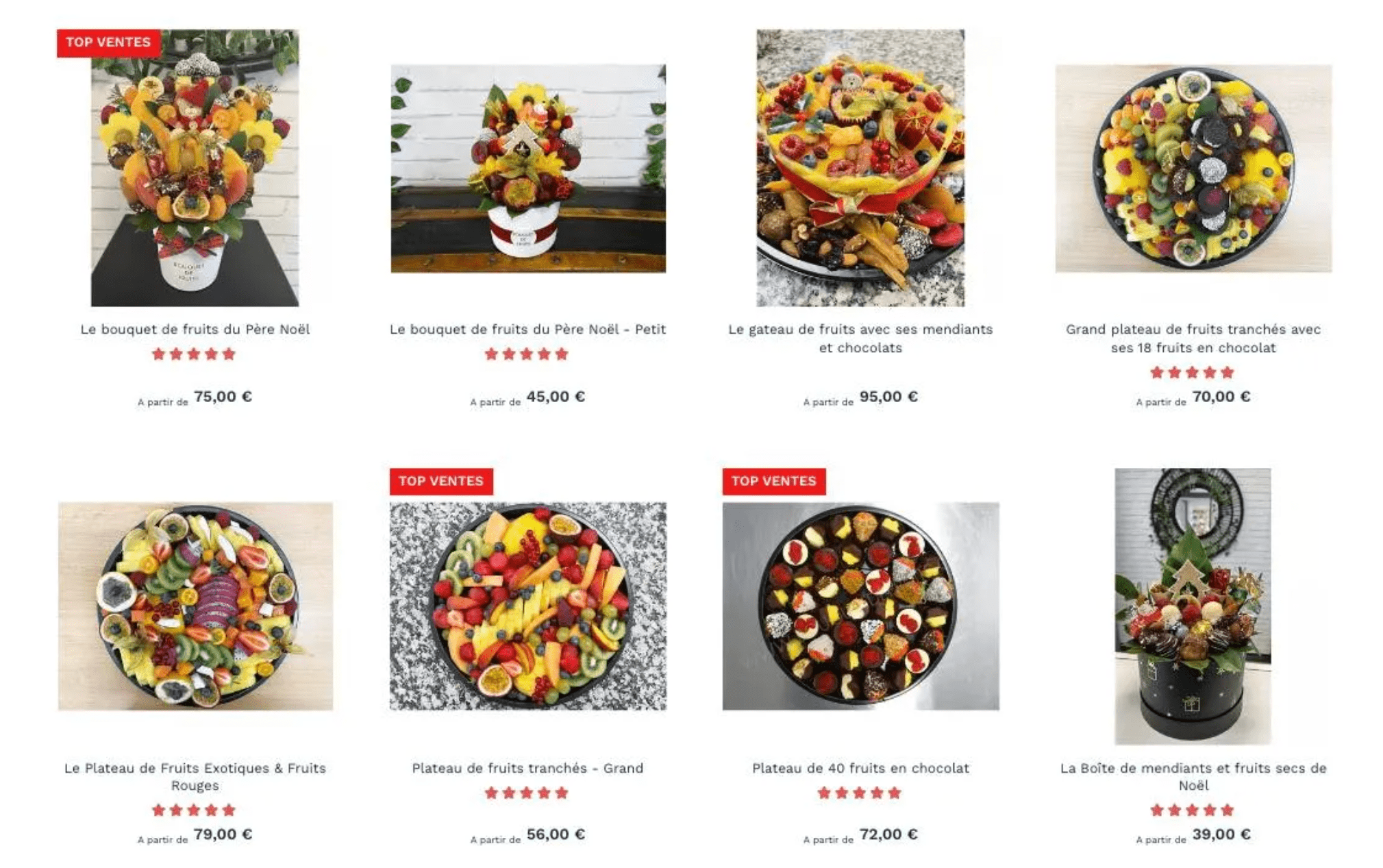
It's now in first place for its primary query “fruit bouquet” and is also positioned very well on various keywords linked to her business such as “fruit platter,” “wedding fruit platter,” “anniversary fruit basket," etc.
The SEO strategy of the Bouquet de Fruits website now allows it to attract significant and qualified traffic, locally and nationally.
Example #2: BMX Avenue
This site example, involving the theme of cycling, is positioned in a competitive market, which doesn't prevent it from being in the Top 5 for the generic keyword “BMX.”
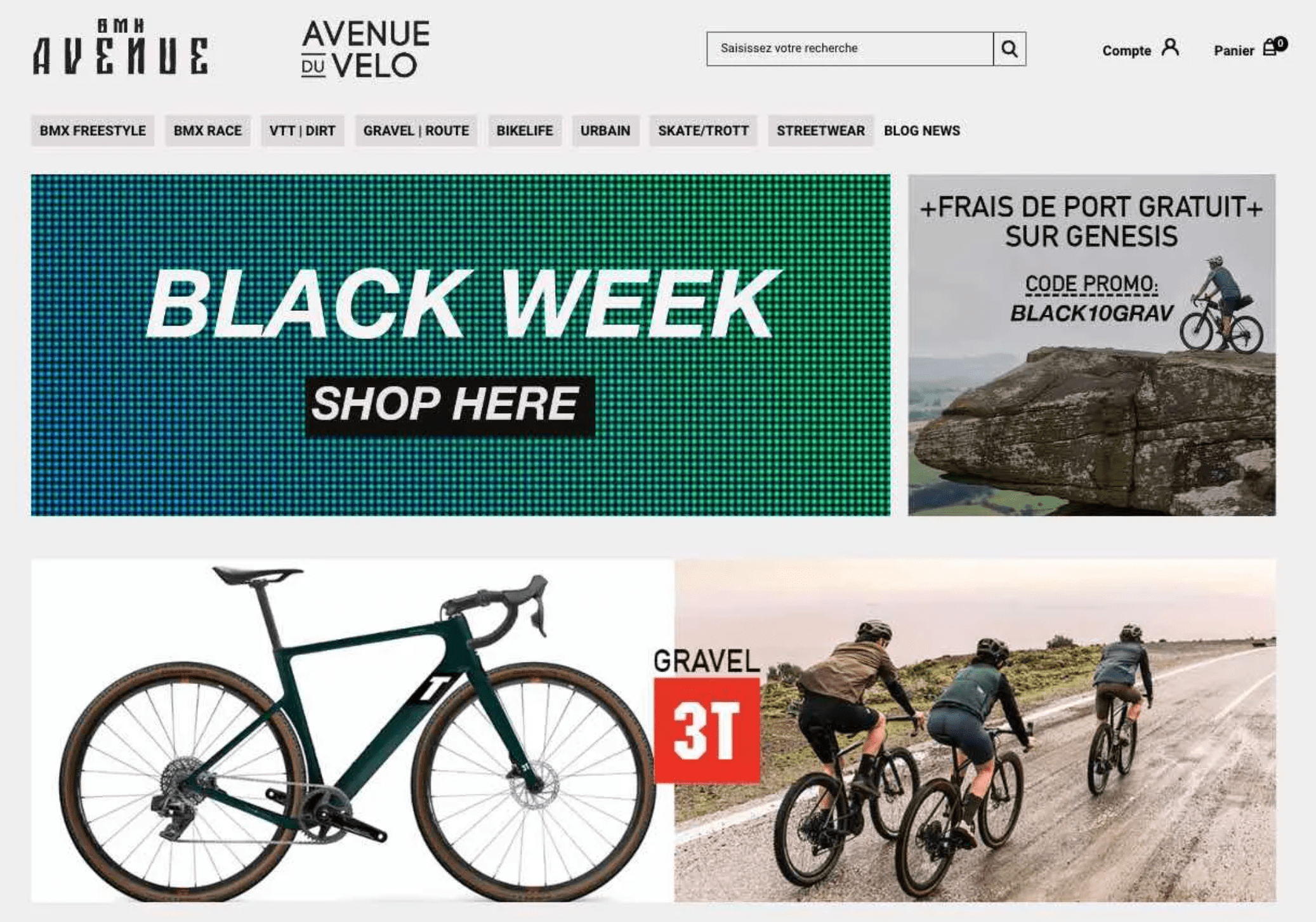
With more than 400 keywords ranking in the Top 3 of the Google search engine, BMX Avenue has had an effective and well-established SEO strategy for several years.
It also targets relevant queries like “bmx freestyle,” “bmx race,” and “bmx cruiser,” and it manages to compete with major players in the theme like Décathlon.
Example #3: Mesepices.com
To finish with the examples of WiziShop stores, I can also cite the Mesepices.com ecommerce site.

With more than 1,200 keywords ranking in the Top 3 of Google, this store is a true benchmark when it comes to the sale of spices on the internet. With its being in the Top 5 for the generic query “spices” and its being in the Top 3 for highly searched keywords like “gum arabic,” “sunflower seed,” “cloves”, etc., it generates significant traffic to its online store.
Take advantage of the benefits of SEO!
You now have everything you need to launch your ecommerce store's SEO, allowing you to boost your Google rankings and attract more traffic over time.
If I have one last piece of advice to share with you, it's to approach ecommerce SEO like a marathon and not a sprint. Regularity is your best ally with this marketing tactic. This is the key to success if you want to rank higher in the search engine results consistently and over the long term.
This acquisition lever requires rigor, patience, and perseverance, but your efforts will undoubtedly ultimately pay off.


![Ecommerce SEO: Complete guide + tips for successful SEO [2026]](https://wizishop.com/media/65951c61adc8fe36aba5c6c0/v1/ecommerce-seo-guide-wizishop.jpg)







